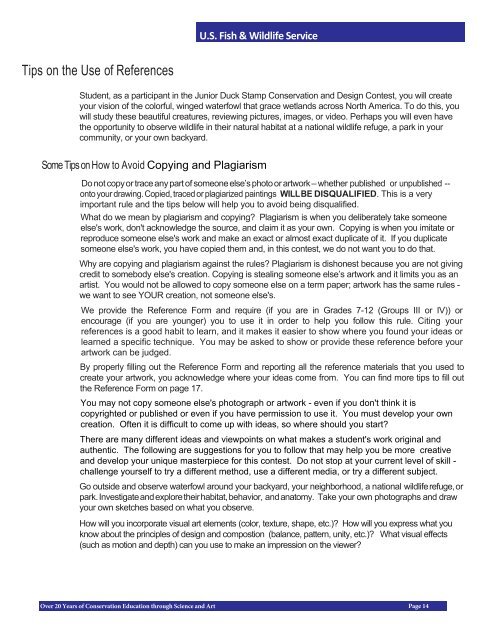Duck Stamp Conservation and Design Program and Art Contest
MFoI7p
MFoI7p
Create successful ePaper yourself
Turn your PDF publications into a flip-book with our unique Google optimized e-Paper software.
U.S. Fish & Wildlife Service<br />
Tips on the Use of References<br />
Student, as a participant in the Junior <strong>Duck</strong> <strong>Stamp</strong> <strong>Conservation</strong> <strong>and</strong> <strong>Design</strong> <strong>Contest</strong>, you will create<br />
your vision of the colorful, winged waterfowl that grace wetl<strong>and</strong>s across North America. To do this, you<br />
will study these beautiful creatures, reviewing pictures, images, or video. Perhaps you will even have<br />
the opportunity to observe wildlife in their natural habitat at a national wildlife refuge, a park in your<br />
community, or your own backyard.<br />
Some Tips on How to Avoid Copying <strong>and</strong> Plagiarism<br />
Do not copy or trace any part of someone else’s photo or artwork – whether published or unpublished --<br />
onto your drawing. Copied, traced or plagiarized paintings WILL BE DISQUALIFIED. This is a very<br />
important rule <strong>and</strong> the tips below will help you to avoid being disqualified.<br />
What do we mean by plagiarism <strong>and</strong> copying? Plagiarism is when you deliberately take someone<br />
else's work, don't acknowledge the source, <strong>and</strong> claim it as your own. Copying is when you imitate or<br />
reproduce someone else's work <strong>and</strong> make an exact or almost exact duplicate of it. If you duplicate<br />
someone else's work, you have copied them <strong>and</strong>, in this contest, we do not want you to do that.<br />
Why are copying <strong>and</strong> plagiarism against the rules? Plagiarism is dishonest because you are not giving<br />
credit to somebody else's creation. Copying is stealing someone else’s artwork <strong>and</strong> it limits you as an<br />
artist. You would not be allowed to copy someone else on a term paper; artwork has the same rules -<br />
we want to see YOUR creation, not someone else's.<br />
We provide the Reference Form <strong>and</strong> require (if you are in Grades 7-12 (Groups III or IV)) or<br />
encourage (if you are younger) you to use it in order to help you follow this rule. Citing your<br />
references is a good habit to learn, <strong>and</strong> it makes it easier to show where you found your ideas or<br />
learned a specific technique. You may be asked to show or provide these reference before your<br />
artwork can be judged.<br />
By properly filling out the Reference Form <strong>and</strong> reporting all the reference materials that you used to<br />
create your artwork, you acknowledge where your ideas come from. You can find more tips to fill out<br />
the Reference Form on page 17.<br />
You may not copy someone else's photograph or artwork - even if you don't think it is<br />
copyrighted or published or even if you have permission to use it. You must develop your own<br />
creation. Often it is difficult to come up with ideas, so where should you start?<br />
There are many different ideas <strong>and</strong> viewpoints on what makes a student's work original <strong>and</strong><br />
authentic. The following are suggestions for you to follow that may help you be more creative<br />
<strong>and</strong> develop your unique masterpiece for this contest. Do not stop at your current level of skill -<br />
challenge yourself to try a different method, use a different media, or try a different subject.<br />
Go outside <strong>and</strong> observe waterfowl around your backyard, your neighborhood, a national wildlife refuge, or<br />
park. Investigate <strong>and</strong> explore their habitat, behavior, <strong>and</strong> anatomy. Take your own photographs <strong>and</strong> draw<br />
your own sketches based on what you observe.<br />
How will you incorporate visual art elements (color, texture, shape, etc.)? How will you express what you<br />
know about the principles of design <strong>and</strong> compostion (balance, pattern, unity, etc.)? What visual effects<br />
(such as motion <strong>and</strong> depth) can you use to make an impression on the viewer?<br />
Over 20 Years of <strong>Conservation</strong> Education through Science <strong>and</strong> <strong>Art</strong> Page 14


